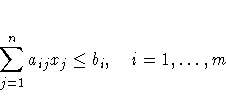Chapter Contents
Previous
Next
|
Chapter Contents |
Previous |
Next |
| The CALIS Procedure |

lincon x1 + 3 * x2 <= 1;
Although you can easily express boundary constraints in LINCON statements, for many applications it is much more convenient to specify both the BOUNDS and the LINCON statements in the same PROC CALIS call.
The LINCON statement can contain only parameter names, operators, and numerical constants. If you need to compute the values of the coefficients aij or right-hand sides bi, you can run a preliminary DATA step and create a TYPE=EST data set containing _TYPE_='LE', _TYPE_='GE', or _TYPE_='EQ' observations, then specify this data set as an INEST= or INVAR= data set in a following PROC CALIS run.
|
Chapter Contents |
Previous |
Next |
Top |
Copyright © 1999 by SAS Institute Inc., Cary, NC, USA. All rights reserved.